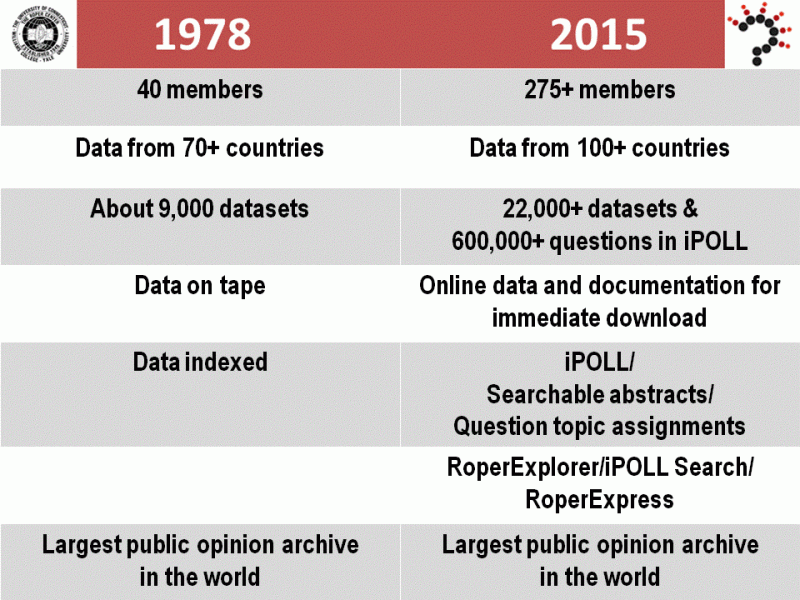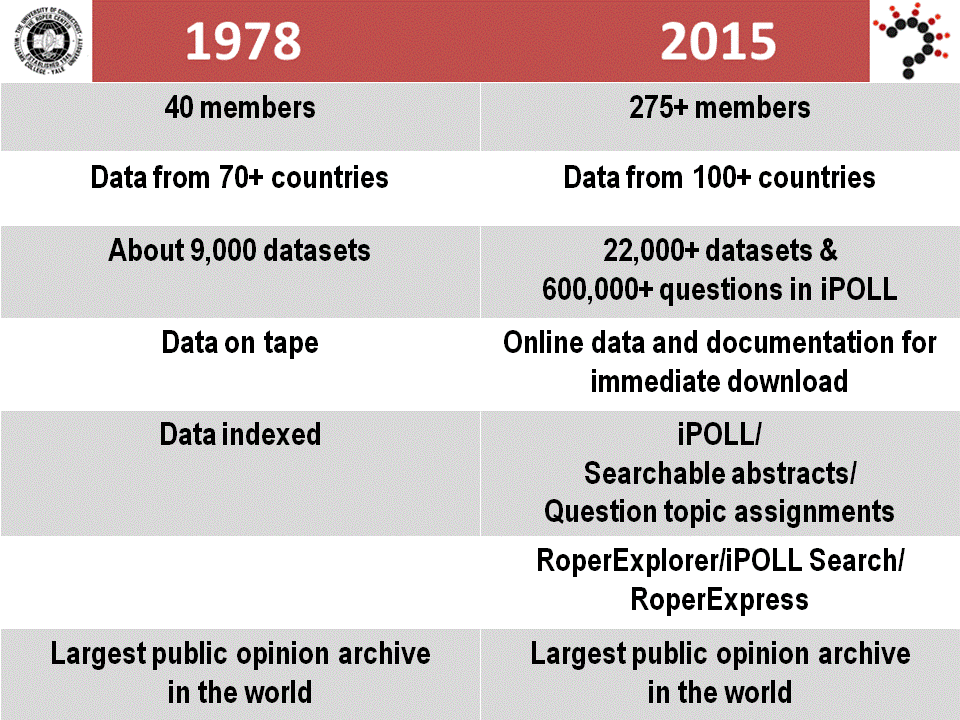In 1978, just after the Roper Center relocated to the University of Connecticut from its first home at Williams College, Donald Deluca, Director of User Services at the Roper Center, reviewed the resources and services of the Center in an article in the Journal of Conflict Resolution. He noted the value of the collection: thousands of surveys from more than 70 countries made available to users from more than 40 member institutions. Looking toward the future, he anticipated “many beneficial changes” resulting from the relocation:
A major effort is underway to bring this immense collection to a higher level of usability as defined by contemporary methods and technologies. […]. Codebooks and documentation will be standardized.
Most of the archive is now on tape. Major efforts will be necessary to clean and reformat much of the data. […] The index system, already valuable, need to be revised and expanded.
Donald Deluca, Director of User Services at the Roper Center
These hopes for the future would be far exceeded in the coming years in large part to committed efforts of the leadership and staff of the Roper Center.
Executive Director Everett C. Ladd took the reins of the Center and set it on its course to prominence. His many publications using Roper data greatly raised the public profile of the archive. To achieve his vision of a major center for public opinion research, he hired an all-star staff, including Marilyn (Potter) Milliken, Lois Timms-Ferrara and Marc Maynard.
Marilyn served as head of user services and information services from the earliest days of the Center at UConn until her retirement just two years ago. Lois started working for the Roper Center in user services under Marilyn in 1982 and became Associate Director in 1997. Marc began his career as an undergraduate at UConn in the early 1980s and became Director of Technical Services in 2000. Their long careers at the Center, from entry-level to leadership, made them an integral part of the monumental changes that occurred during the Center’s time at the University of Connecticut.
Over the decades, the collection grew enormously. What began in 1947 as one hundred fifteen studies from Elmo Roper had become nine thousand surveys from over one hundred organizations by 1980. Today the archive holds over 22,000 datasets, the largest collection of public opinion research in the world. More than 100 countries are represented, including major holdings from Japan and Latin America. Every major polling organization in the U.S. is represented in the collection, nearly two hundred organizations, with hundreds more sponsors and collaborators.
Standardizing codebooks and documentation was just the beginning of the improvements in data preservation. The Roper Center achieved excellence in data curation. Marilyn’s work in this area was continued and expanded by Cindy Teixeira, who started at the Roper Center in 2001. Cindy became Manager of Archival Development in 2005 and led a major effort to clean historical data and apply modern metadata standards. In 2015, the Center was awarded the Data Seal of Approval for meeting strict criteria for the preservation of data that is accessible, usable, reliable, and identifiable.
Far beyond the expansion of the indexing system to locate survey questions, the creation of the POLL database in 1986 greatly improved the ease and speed with which researchers could locate relevant data, and in doing so, expanded the impact of the collection by increasing the user base. Shortly after the launch of POLL, Information Today recognized its value of by awarding it the first “Buddie Award” for “Best Unknown Database.” From POLL, Marc developed iPOLL, the easily-accessible database system with a user-friendly interface that researchers rely upon today, a unique tool that is essential to all scholars of public opinion and all designers of surveys. Access to datasets was also improved. Files on tape and waits to receive copies of datasets are a thing of the past; the majority of datasets can be downloaded instantly via RoperExpress, including 93% of U.S. surveys.
iPOLL and RoperExpress were not the only technological improvements the staff of the Center developed to improve user experience. In recent years, iPOLL Plus and RoperExplorer have offered users easy access to demographic breakdowns and crosstabs. The Roper Center website has become an important resource in its own right, offering valuable content including educational materials, regularly updated presidential approval ratings, vote history by demographic variables, and articles on important topics in public opinion.
Improvements to the collection, the curation, and the technological tools made membership in the Roper Center essential to academic institutions, media organizations, and non-profits and private companies engaged in survey research. Executive Director Marc Abrahamson’s plan to grow the Center and build a path to financial independence included not just intensified collection efforts, but a focus on membership development. As a result of Lois’ unflagging efforts to promote the Center and to develop and sustain strong relationships with librarians, data providers, and researchers, membership has increased to over 275 institutions.
In addition to bringing constant improvement to the Center itself, the staff have also worked with the Board and the Executive Directors to ensure that the Center has been deeply engaged with the polling research and data archives communities. Staff have made important contributions to both areas through service in professional organizations like iASSIST and AAPOR, publications, presentations, and education and training. These activities have not just enhanced the Center’s processes and services, they have also strengthened the ties to data providers, member institutions, and users that form the Center’s foundation.
Additional staff members brought their industry, creativity, and commitment to making the Center what it is today. Terry Emmons provided stellar financial and administrative support to members and staff for nearly thirty years. Darlene Hart developed and maintained the website that provides users access to our data and gives the Center its public face. Kaylee Sawyer provided tireless assistance in support of membership, conference exhibits, and the yearly Mitofsky dinner. Lindsey Pellino provided valuable support in datasets archiving and wrote about new and old studies for the website. Through the years, important contributions have been made by a many other dedicated team members, from students to career professionals, all of whom have shared the Roper Center’s mission to preserve the “voice of the people” into the future.
As the Roper Center moves to Cornell University, we are honored and thrilled to build on the amazing efforts of the incredible leaders and team from the University of Connecticut. Of course, our gratitude also extends to those who came before them at Williams College and to Elmo Roper himself, who had the prescience to foresee the importance of the then-new field of public opinion research and to preserve and make accessible the data for all future generations.
Many thanks to the staff and leadership of the Roper Center for all they have done.

